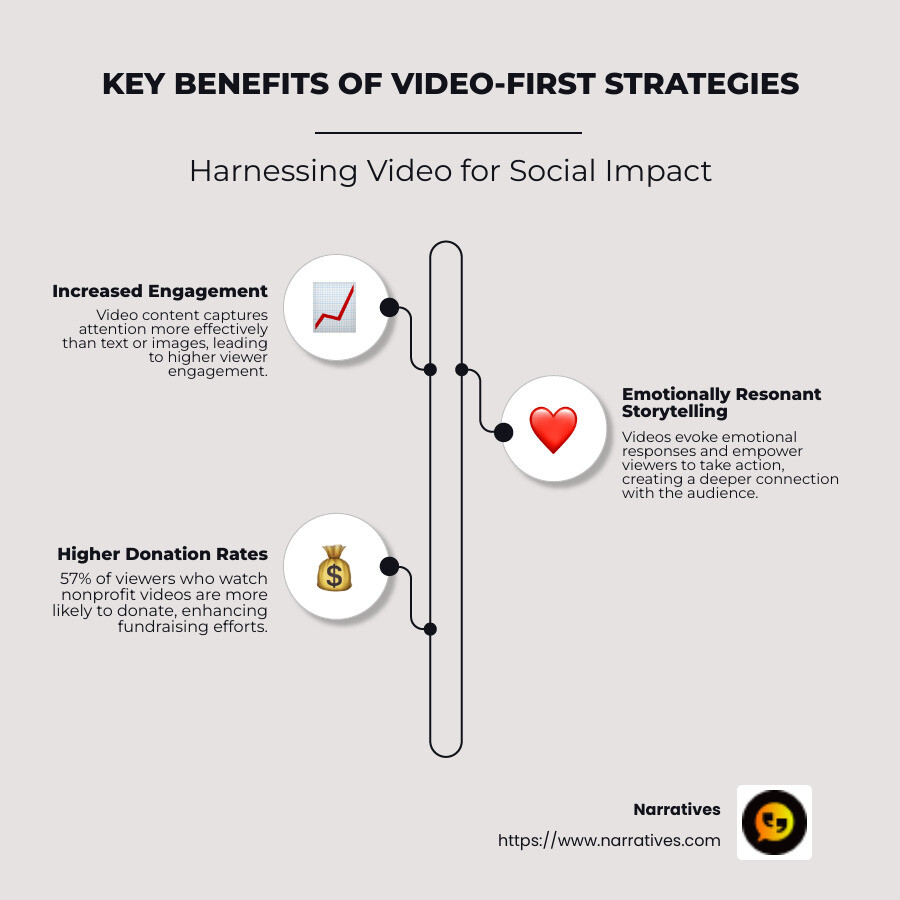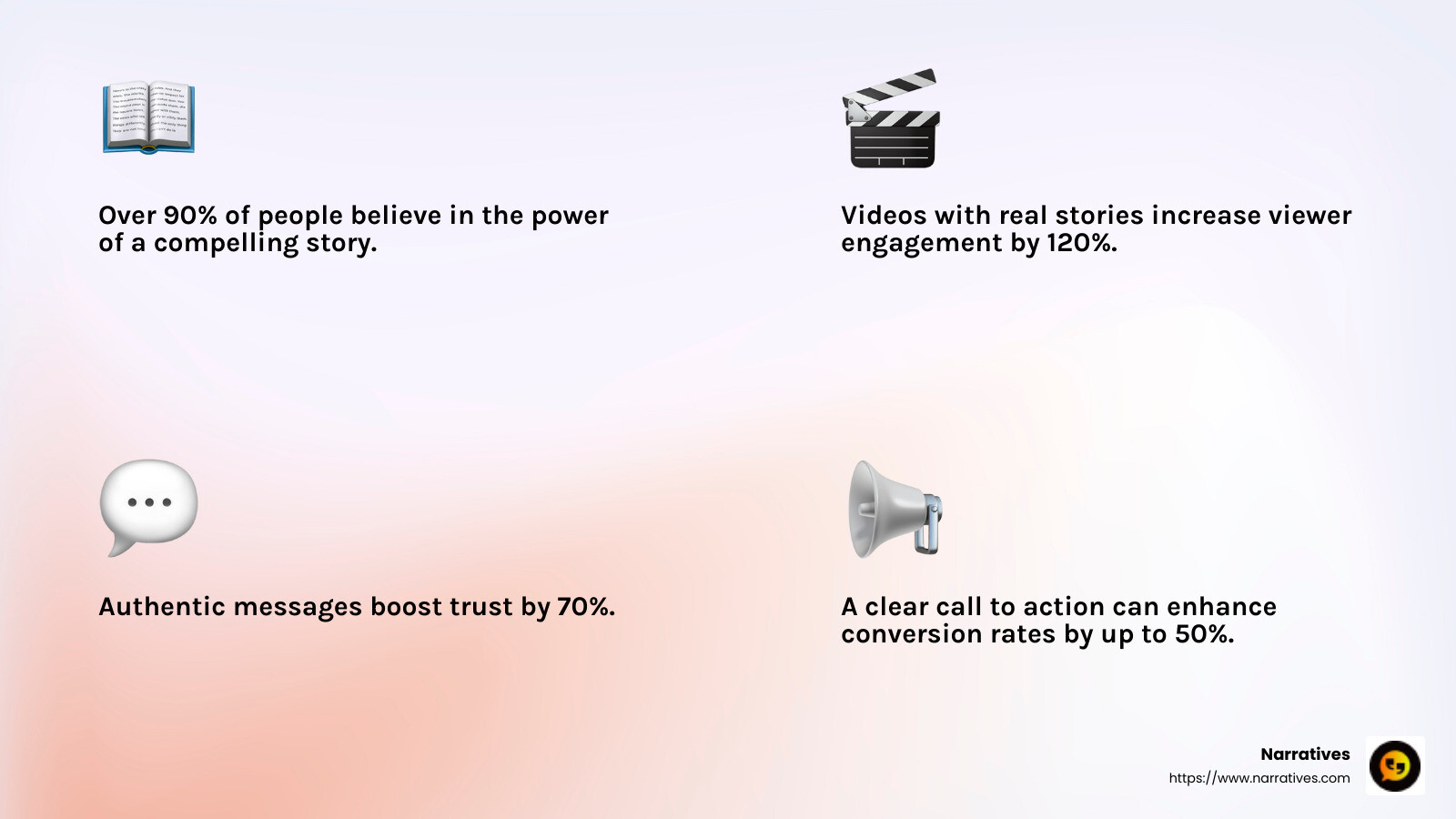From Vision to Video: Mastering Social Impact Strategies

Social impact video strategies have become a vital component of modern nonprofit marketing. For organizations with missions focused on advocacy, DEI, or social justice, mastering these strategies can significantly amplify their message. Here are some key reasons this approach is so crucial:
Video attracts attention, engaging audiences more effectively than text or images alone.
Nonprofits benefit greatly from video; 57% of viewers who watch nonprofit videos donate.
Storytelling in video form evokes emotional responses and empowers viewers to act.
In this modern age of video-first marketing, nonprofits need to harness the potential of video not just to spread awareness, but to drive meaningful change and donations. According to 2017 research, nonprofits incorporating video saw boosts in donation rates, email engagement, and overall audience interaction. Video doesn't just tell your story; it lets viewers live it. By strategically employing video, organizations can reach new heights of social impact and storytelling.

The Power of Social Impact Video Strategies
Social impact video strategies are changing how organizations connect with audiences. These strategies are not just about creating content; they're about sparking engagement, evoking emotional responses, and inspiring action.
Engagement
Videos are a powerful tool for capturing attention. They engage audiences more deeply than text or images alone. A study highlighted that video posts on Facebook achieve higher engagement scores than any other type of content. This is because videos can convey complex ideas quickly and effectively, making them ideal for today’s digital world.
Emotional Response
The real magic of video lies in its ability to evoke emotions. When viewers see stories unfold on screen, they form connections with the characters and narratives. This emotional engagement is crucial for social impact. Videos that tell compelling stories can motivate viewers to care about issues they might otherwise overlook. For instance, nonprofit videos have a 57% conversion rate for donations, showing the power of emotional storytelling.
"Video doesn't just tell your story; it lets viewers live it."
Inspiring Action
The ultimate goal of social impact videos is to inspire action. Whether it's signing a petition, donating to a cause, or volunteering time, videos can drive viewers to take tangible steps. A well-crafted video ends with a clear call to action, guiding viewers on how they can contribute to the cause. This could be as simple as sharing the video on social media or as involved as joining a community group.
By integrating social impact video strategies, organizations can not only raise awareness but also drive real-world change. Videos have the power to transform passive viewers into active participants in the mission, making them an invaluable tool for any nonprofit looking to make a difference.
In the next section, we'll dig into crafting a strategy that ensures your videos are not just seen, but felt, and acted upon.
Crafting Your Social Impact Video Strategy
Creating an effective social impact video strategy starts with a solid plan. This plan should focus on your content strategy and target audience. Let's break it down into easy steps.
Planning
Before diving into video production, take time to outline your goals. Ask yourself:
- What message do you want to convey?
- What action do you want viewers to take after watching?
Define your goals clearly. This will guide your entire video creation process. A well-planned video has a clear beginning, middle, and end. It should also include a strong call to action.
Content Strategy
A focused content strategy is key. Each video should revolve around a single concept. Avoid cramming too many ideas into one piece. Shorter videos, ideally between 90 seconds to two minutes, work best for capturing attention.
- Narrative Arc: Craft a compelling story. Use storytelling techniques to create an emotional connection with viewers.
- Visuals and Sound: Prioritize high-quality visuals and clear audio. Even simple tools can achieve great results if lighting and sound are well managed.
Target Audience
Understanding your audience is crucial. Tailor your content to their interests and needs. Ask these questions:
- Who is your primary audience?
- What do they care about?
- How can your video address their concerns?
Research shows that videos resonate well with Millennials, who are more likely to engage with video content before making a donation.
"To reach your audience, you must speak their language and address their needs."
By focusing on planning, crafting a clear content strategy, and understanding your target audience, you can create videos that not only capture attention but also drive meaningful action. This strategic approach ensures your social impact videos are not just watched, but truly felt and acted upon.
In the next section, we'll explore best practices for creating impactful videos that resonate with authenticity and purpose.
Best Practices for Creating Impactful Videos
Creating impactful videos hinges on three key elements: storytelling, authenticity, and a compelling call to action. Let's explore how each of these can lift your social impact video strategies.
Storytelling
Storytelling is the heart of any engaging video. A well-told story can create an emotional connection with your audience, making your message more memorable and persuasive.
Craft a Narrative Arc: Your video should have a clear beginning, middle, and end. This structure helps guide the viewer through your message. Start with a hook to grab attention, build your story with engaging content, and conclude with a strong resolution.
Use Real Stories: Real-life stories resonate more than abstract concepts. Share stories of individuals or communities impacted by your cause. This humanizes your message and makes it relatable.
Visual and Emotional Appeal: Combine visuals with emotional storytelling to engage viewers. A powerful story can inspire empathy and motivate action.
Authenticity
Authenticity builds trust. Viewers can easily spot when a message feels forced or insincere. Here’s how to keep it real:
Be Genuine: Let your passion for your cause shine through. Speak from the heart and be transparent about your intentions.
Show Real People: Feature real people and real stories in your videos. Avoid actors or scripted performances. Authenticity is about showing the genuine impact of your work.
Consistency: Make sure your video aligns with your organization's values and mission. Consistent messaging reinforces authenticity.
Call to Action
Every impactful video needs a call to action (CTA). This is where you guide viewers on what to do next.
Clear and Direct: Your CTA should be straightforward. Whether it's donating, volunteering, or sharing the video, make sure it's easy for viewers to understand what you want them to do.
Visible and Memorable: Place your CTA at the end of the video and ensure it's memorable. Use text, voiceover, or both to reinforce the message.
Encourage Engagement: Invite viewers to engage further with your content. This could be through visiting your website, following your social media, or joining a mailing list.

By incorporating storytelling, authenticity, and a strong call to action, your videos can effectively engage audiences and inspire them to take meaningful steps toward your cause.
In the following section, we will discuss how to measure the impact of your videos, ensuring your efforts are driving the change you aim to achieve.
Measuring the Impact of Your Videos
Understanding how your videos perform is crucial for refining your social impact video strategies. By focusing on impact measurement, data analysis, and storytelling, you can ensure your videos are not just seen but also make a real difference.
Impact Measurement
To measure the impact of your videos, go beyond just counting views and likes. These surface-level metrics don’t tell the whole story.
Track Comprehensive Metrics: Look at viewer retention, watch times, and click-through rates. These metrics reveal how engaged your audience is and how effectively your video retains attention.
Analyze Conversions: Connect your videos to tangible outcomes like donations, sign-ups, or shares. This helps you understand if your video inspires action and meets your social impact goals.
Align with Objectives: Ensure the metrics you track align with your campaign objectives. Are you trying to raise awareness, drive donations, or change behaviors? Your metrics should reflect these goals.
Data Analysis
Data analysis is key to understanding what works and what doesn’t in your video campaigns.
Use A/B Testing: Experiment with different versions of your videos, titles, and CTAs. A/B testing helps identify what resonates most with your audience, allowing for continuous improvement.
Accept Feedback: Encourage audience feedback through comments and surveys. This qualitative data provides insights into audience perceptions and can guide future content creation.
Leverage Tools: Use analytics tools to streamline data collection and analysis. These tools can provide in-depth insights into viewer behavior and campaign performance.
Storytelling
Storytelling remains a powerful tool not just for creating videos but also for measuring their impact.
Qualitative Insights: Use storytelling to understand how your audience connects with your content. Are the stories you tell resonating and inspiring action?
Feedback Loops: Create a feedback loop where audience stories and experiences inform future videos. This not only enriches your content but also ensures it remains relevant and impactful.
Narrative Adjustments: Based on data and feedback, refine your narratives. If a certain story element isn’t working, don’t hesitate to adjust it for better engagement.
By focusing on comprehensive metrics, leveraging data analysis, and refining storytelling, you can measure the true impact of your videos. This approach ensures that your efforts are not only reaching your audience but also driving the meaningful change you aspire to achieve.
Next, we'll address common questions about social impact video strategies to help you further refine your approach.
Frequently Asked Questions about Social Impact Video Strategies
How do social impact videos inspire action?
Social impact videos have a unique ability to move people to action by engaging emotions and making issues relatable. A compelling video can do more than just inform—it can create an emotional connection that inspires viewers to act. For example, the "Ice Bucket Challenge" for ALS went viral because it combined a fun activity with a heartfelt cause, leading to increased donations and awareness.
Videos can show real-life stories, putting faces to issues that might otherwise seem abstract. This storytelling approach helps viewers understand the impact of their actions and feel more connected to the cause. A 2017 study found that 57% of people who watched nonprofit videos made a donation, showing the power of video to inspire tangible outcomes.
What are the key elements of a successful video strategy?
Creating a successful video strategy involves several key elements:
Clear Goals: Define what you want to achieve with your video. Are you aiming to raise awareness, drive donations, or inspire volunteerism? Clear goals guide your content creation and measurement efforts.
Audience Relevance: Tailor your content to the interests and needs of your target audience. Understanding your audience helps ensure your message resonates and encourages engagement.
Compelling Storytelling: Use storytelling to engage viewers emotionally. Stories that highlight personal experiences and outcomes are more likely to inspire action.
Call to Action (CTA): Every video should include a clear and compelling CTA. Whether it's asking viewers to donate, share, or participate, a strong CTA guides the audience toward the desired action.
Platform Optimization: Optimize videos for the platforms where they will be shared. Each platform has different strengths, so tailor your content to fit, whether it's short clips for Instagram or longer narratives for YouTube.
How can nonprofits measure the success of their video content?
Measuring the success of video content goes beyond counting views and likes. Here are some effective ways nonprofits can assess their video impact:
Engagement Metrics: Track metrics like viewer retention, watch time, and click-through rates. These indicators show how well your video holds attention and prompts further interaction.
Conversion Rates: Link videos to specific outcomes, such as donations or sign-ups. This helps determine if the video effectively drives the desired actions.
Feedback and Surveys: Collect qualitative data through comments and surveys to understand audience perceptions and gather insights for future content.
A/B Testing: Experiment with different video versions to see which elements perform best. A/B testing can reveal what resonates most with your audience, allowing for optimization.
By focusing on these elements, nonprofits can ensure their video content not only reaches their audience but also drives meaningful action and impact.
Conclusion
At Narratives, we believe in the transformative power of community-driven storytelling. It's not just about sharing stories; it's about amplifying voices that often go unheard and making a real difference. Our commitment to working with non-profits and purpose-driven organizations allows us to create content that resonates deeply and inspires action.
Non-profit partnerships are at the heart of what we do. By collaborating closely with these organizations, we help them tell their stories in a way that highlights their impact and mission. This partnership approach ensures that the content we produce is authentic and aligned with the values and goals of the organizations we serve.
Through our focus on community-driven storytelling, we aim to build trust and foster connections. When stories come from within the community, they are more relatable and powerful, sparking empathy and understanding. This, in turn, encourages viewers to engage and support the cause.
Incorporating social impact video strategies into your communications plan can significantly improve your reach and effectiveness. By leveraging the emotional power of video, you can connect with your audience on a deeper level, inspiring them to take meaningful action.
As we continue to build our reputation as the go-to digital storytelling partner, our goal is to support non-profits in sharing their impact stories. By doing so, we not only help these organizations grow but also contribute to a broader movement that values people and the planet. Let's create stories that inspire change and make the world a better place, one video at a time.



